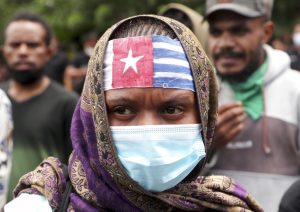Late last week, the governor of Indonesia’s Papua province gave an interview with Reuters in which he cast doubt about the government’s controversial plans to create new provinces in the restive eastern region.
Last month, the Indonesian parliament announced plans to split the provinces of Papua and West Papua into five administrative divisions, via the creation of South Papua Province, Central Papua Province, and the Papua Central Highlands Province. But Governor Lukas Enembe told the news agency that the government lacks the resources to run the proposed new provinces. He added that Papuans were not properly consulted about the plan, which has prompted widespread protests.
“There are so few of our people here to create new provinces,” Enembe said, adding that creating the new administrative units could lead to a further influx of people from outside Papua, with the implication that this could inflame local resentment.
Whether Enembe’s comments suggest that the Indonesian government might be reconsidering its plans remains unclear. After the announcement of the plan, one member of the parliamentary commission overseeing home affairs told local media that the House of Representatives hoped to pass the three bills authorizing the creation of the new provinces “before June.” The goal, the MP said, is to have everything squared away so that voters can elect the new provinces’ regional leaders and legislative representatives at general elections in 2024.
The push for the formation of new administrative units in Papua has taken place after the Indonesian parliament renewed and amended the Papuan Special Autonomy Law, which shapes the administration of the region, in July of last year. According to a report by the Jakarta Post, the amended law includes a provision that allows the Indonesian government to create new provinces, cities, and regencies without the approval of the Papuan People’s Assembly (MRP) or the existing provincial level legislative councils. The MRP has since claimed that it was not consulted about the creation of the new provinces.
The government’s rationale for the subdivision of Papua and West Papua is that it will produce more manageable administrative areas that will help promote good governance and economic development in the region, which on most measures lag behind the rest of Indonesia. This, in theory, will wean the population away from the separatist struggle that has existed since Papua’s absorption by President Suharto’s New Order regime following a flawed referendum in 1969. Indeed, pacification-by-prosperity was the overarching logic of the Special Autonomy Law, which was first passed in 2001 in a bid to address the local discontent that was swelling the ranks of the separatist cause.
But despite these intentions, the subdivision plan has prompted protests across Papua, with many assuming quite reasonably that they will deepen Jakarta’s encroachment into the region and do little to help local people. As one indigenous representative told Reuters last month, “This is a form of state violence that seeks to eradicate the lives of Papuans.”
The Papuan liberation movement has long viewed infrastructure development in particular as the thin edge of the wedge in terms of environmental destruction, militarization, the exploitation of its natural resources, and the arrival of migrants from other parts of Indonesia. For this reason, large-scale infrastructure projects including the 4,300-kilometer Trans-Papua mega-highway, have frequently been targeted by separatist rebels. This in turn has spurred further deployments of troops, and further resistance.
As a result, many observers claim that the plan to create new provinces is likely to complicate efforts for a peaceful solution to the Papua conflict. In an article for the Lowy Institute’s Interpreter blog late last month, the Jakarta-based journalist Eduard Lazarus wrote that the provincial subdivision plan was a sign of “a fatal disconnect between how the Indonesian government view their treatment of the region, and how the people actually affected by such treatment see the arrangement.”
“These designs for proliferation have ramifications far beyond altering arbitrary lines on a map,” Lazarus argued. “The creation of new administrative districts entails the necessity to establish government apparatus, set up military posts, and construct new infrastructure – all of which might exacerbate violent conflict in the region.”
































